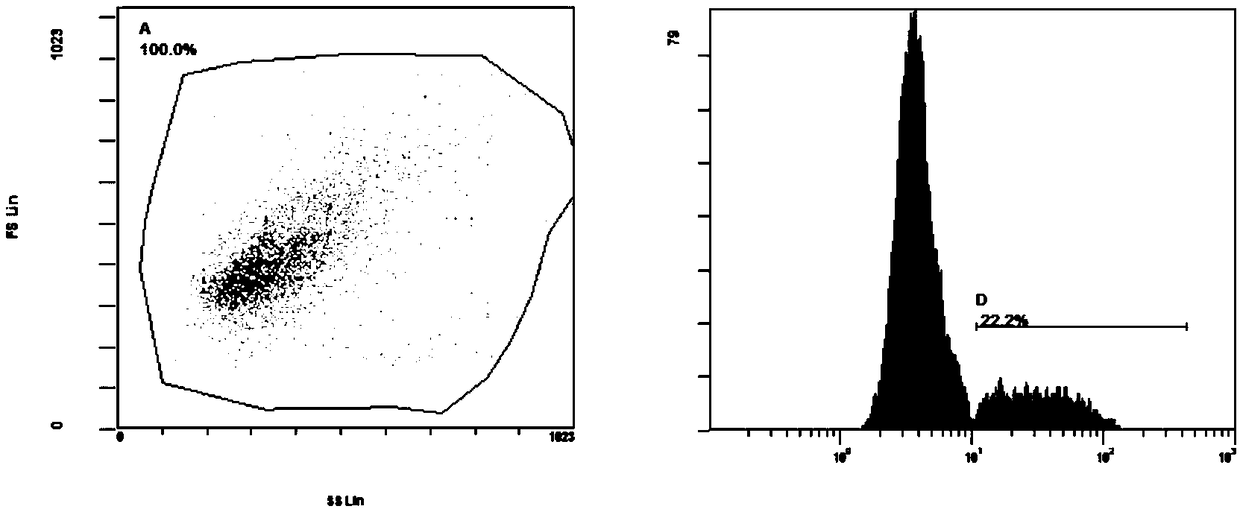Nucleic acid for treating HCC (Hepatocellular Carcinoma), preparation method thereof, CAR-T (Chimeric Antigen Receptor T) cell having nucleic acid and preparation method of CAR-T cell
A nucleic acid and cell technology, applied in the field of genes, can solve the problem that the tissue killing of liver cancer needs to be improved
- Summary
- Abstract
- Description
- Claims
- Application Information
AI Technical Summary
Problems solved by technology
Method used
Image
Examples
Embodiment 1
[0043] The nucleic acid used for treating HCC includes at least the CD226 costimulatory region nucleic acid sequence as described in SEQ ID NO.6 and the 4-1BB costimulatory region nucleic acid sequence as described in SEQ ID NO.7.
[0044] In this example, if figure 1 Shown, the nucleic acid sequence that is used for the treatment of HCC comprises the CD8Leader nucleic acid sequence as described in SEQ ID NO.2 of sequential connection; The GPC3scFv nucleic acid sequence as described in SEQ ID NO.3; CD8α as described in SEQ ID NO.4 The nucleic acid sequence of the hinge region; the CD8α transmembrane region nucleic acid sequence as described in SEQ ID NO.5; the CD226 co-stimulatory region nucleic acid sequence as described in SEQ ID NO.6; the 4-1BB co-stimulatory region as described in SEQ ID NO.7 Stimulatory region nucleic acid sequence; CD3ζ signaling region nucleic acid sequence as described in SEQ ID NO.8.
Embodiment 2
[0046] A method for preparing a nucleic acid for treating HCC, comprising the steps of:
[0047] (1) According to artificial nucleic acid sequence of Leader, artificial nucleic acid sequence of GPC3 single-chain antibody, artificial nucleic acid sequence of CD8 hinge region, artificial nucleic acid sequence of CD8 transmembrane region, artificial nucleic acid sequence of CD226 costimulatory region, artificial nucleic acid sequence of 4-1BB costimulatory region , CD3ζ signaling region nucleic acid artificial sequence to synthesize the entire expression frame and insert it into the standard vector pUC to obtain pUC-GPC3-226BB-CAR;
[0048] (2) Carry out double enzyme digestion of pUC-GPC3-226BB-CAR, use agar electrophoresis to cut off the agar part of the GPC3-226BB-CAR DNA fragment agar, use the DNA extraction kit sol solution to treat, pass through the DF column, discard the filtrate, and rinse the DF Column, empty, elute the DF column, collect the centrifuge, and obtain the p...
Embodiment 3
[0053] A plasmid, the plasmid is the pLent-GPC3-226BB-CAR plasmid obtained by inserting the fusion gene fragment GPC3-226BB-CAR DNA into the lentiviral expression vector pLent-C-GFP. The plasmid was prepared by the following preparation method: the above-mentioned purified GPC3-226BB-CAR DNA fragment and the linearized pLent-C-GFP DNA fragment were combined in the ligation system: 10×buffer: 1 μl; T4 ligase: 1 μl; GPC3 -226BB-CAR DNA fragment: 4 μl; linearized pLent-C-GFP DNA fragment: 4 μl, ligation formed.
[0054] In this example, the plasmid was prepared by the following method:
[0055] According to artificial sequence of Leader nucleic acid, artificial sequence of GPC3 single-chain antibody nucleic acid, artificial sequence of nucleic acid of CD8 hinge region, artificial sequence of nucleic acid of CD8 transmembrane region, artificial sequence of nucleic acid of CD226 costimulatory region, artificial sequence of nucleic acid of 4-1BB costimulatory region, CD3ζ signal Th...
PUM
 Login to View More
Login to View More Abstract
Description
Claims
Application Information
 Login to View More
Login to View More - R&D
- Intellectual Property
- Life Sciences
- Materials
- Tech Scout
- Unparalleled Data Quality
- Higher Quality Content
- 60% Fewer Hallucinations
Browse by: Latest US Patents, China's latest patents, Technical Efficacy Thesaurus, Application Domain, Technology Topic, Popular Technical Reports.
© 2025 PatSnap. All rights reserved.Legal|Privacy policy|Modern Slavery Act Transparency Statement|Sitemap|About US| Contact US: help@patsnap.com



